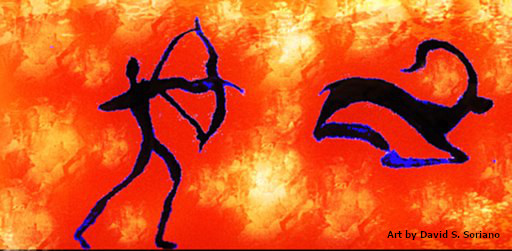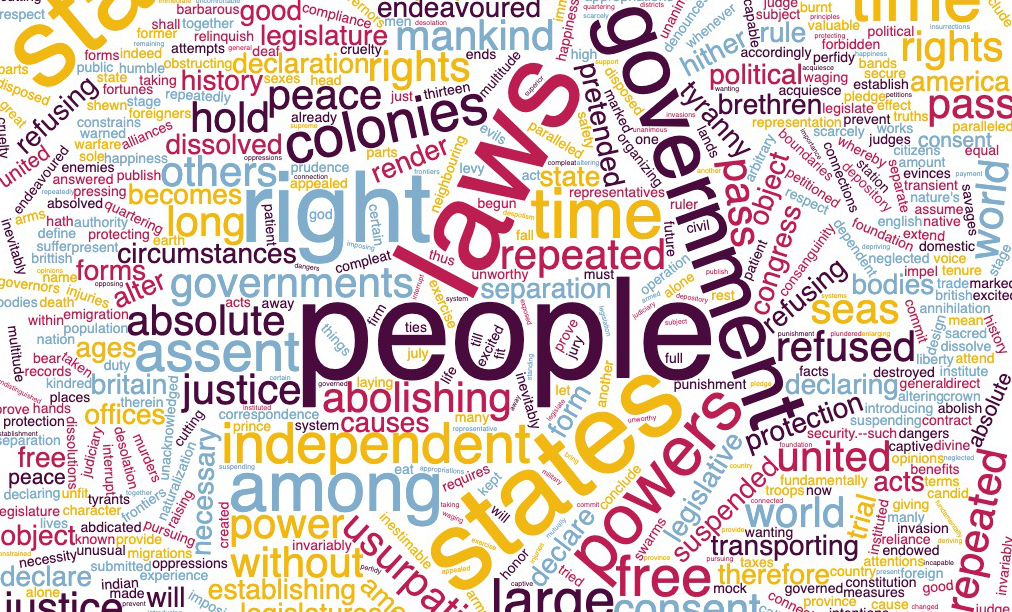
Human beings have always been tool users. Fire let us wake little suns; arrowheads gave us talons like eagles; wolfskins sent us out across Ice Age Europe; and language—whether spoken, written, printed, or coded—fueled every innovation since.
Our brains require such tools. After all, those three-pound puddings of nerve and fat in our skulls haven’t changed much since we first fashioned arrowheads. In fact, in her new book, The Extended Mind, Annie Murphy Paul argues that we’re probably already using our brains at near-peak capacity.
Thinking harder is not the answer. Thinking outside the brain is. We need to grab hold of tools beyond our brains in order to think better.
Let’s start with the first thinking tool our ancestors learned to use: the space around us.
How can the physical world help us think?
From our earliest days, humans have built mental maps of the environment. Where is the water? Where do the game trails run? Which caves hold bears? Where can we find berries and roots and honey?
It’s not surprising, then, that our brains connect memory to space. We can use mental mapping to help us and our students remember complex information.
One powerful technique involves creating a “memory palace.” Here’s how it works:
- Choose a location that you know well, one that you can mentally walk through, knowing where everything is.
- Name this mental space, such as “Memory House” or “Memory Garden.”
- Select something you must remember.
- Your friend’s birthday is August 16.
- Connect each detail to something physical that you imagine in your memory space.
- You walk into the living room of your memory house and see your friend sitting next to an open window and holding a “Happy Birthday” balloon. The balloon gets wafted by a gust (August) of wind from the window. On a nearby couch sit six teens (16) wearing party hats.
- Whenever you need to remember the information, return to your memory space to experience the moment again. At a certain point, you won’t have to return because you’ll just know.
- Use your memory space to sequence complex information.
- You step into the dining room where you are hosting a superhero party. A big Helium balloon says, “Noble Gases!” and a Neon sign in the window says “Party Here!” You know that your guests won’t shake your hand or even acknowledge you, because Noble Gases don’t interact. Still, you smile at a hero who looks like Aragon (Argon) from The Lord of the Rings. Next to him stands Superman, last son of Krypton. Beside him stands a Xenomorph monster from the movie Alien (Xenon). Last, you see Madame Curie with a box full of radium (Radon).
Annie Murphy Paul reports one experiment in which experts using the memory-palace technique recalled 71 of 72 random words presented to them, while other test subjects averaged just 29. However, after six weeks of training, those same novice subjects could recall nearly 60 of the 72 words.
We all have built-in memory palaces, and we can use them to strengthen our thinking. We can also use visuals of all sorts.
How can visuals extend our minds?
Seeing is believing, so if you want students to remember a concept, present it visually. Better yet, have them create their own visuals to represent abstract concepts:
- Draw an important character, setting, or object from a story you are reading.
- Make a life map showing major events that led you to this moment.
- Create a symbol that would positively represent your worldview.
- Build a mind map that shows your connections to others at school, at home, and elsewhere.
- Create a line diagram of the organization of your school.
- Create a flowchart to show how a bill becomes a law.
- Draw a floorplan of a place that is important to you.
- Find a photo of an animal or plant and label the parts.
- Draw a diagram of a machine, showing how the parts work.
- Print out a color wheel and label each color with an emotion you associate with it.
- Create a cause-effect chart to show why something happens and what results.
- Design a poster to promote a scientific concept.
- Pick an amazing work of art and write a story based on it.
- Draw a plot line of a great experience you had.
- Paste an important document into Wordclouds.com to visualize the concepts in it. (The following word cloud comes from the Declaration of Independence.)

You and your students can take the power of 2-D visualization to the 3rd dimension with modeling.
How does modeling improve thinking?
Modeling allows abstract ideas to take physical form. Thoughts become things that can be manipulated.
Annie Murphy Paul shares the story of how James Watson and Francis Crick were stuck. They were trying to discover the structure of DNA, but none of their experiments or calculations had arrived at the answer. Finally, in desperation, Watson turned to cardboard, building 3-D molecule models. After quite a bit of fiddling, he realized that a double-bonded pair of adenine and thymine had the same shape as one of guanine and cytosine. He had the rungs, and physically manipulating his models brought him to the double-helix ladder. The pattern was so regular, so easy to replicate, and so in keeping with everything they knew about how DNA functions that Watson and Crick immediately knew they had the right shape.
Students, too, can create 3-D models, including architectural projects, dioramas, terrariums, scale models, sculptures, and machines. The materials can be commonplace: popsicle sticks, toothpicks, cardboard, glue, tape, pipe cleaners, fishing wire, clay, papier-mâché, etc. What’s important is the thinking that model-making allows.
Here are some suggestions for different subject areas:
Language Arts
- Character statues/dolls (Hester Prynne, Nancy Drew, Mr. Hyde, Patina from the "Track" series)
- Setting dioramas (Scout’s neighborhood, Bag End, the little house on the prairie)
- Language models:
- Create a physical representation of a vocabulary term.
- Devise a physical representation of a noun (toy car), a verb (racetrack), an adjective (car decal), and an adverb (stairs that the track runs down).
- Build a model that shows each part of a prepositional phrase.
- Build structures that represent simple, compound, and complex sentences.
- Create a machine that demonstrates what a particular verb does to its direct object (e.g., throw ball or draw line).
- Create a physical representation of paragraph structure.
- Build a physical representation of essay structure.
- Build a physical model of plot structure.
Science
- Body part models (cells, muscles, joints, eyes, hearts, brains)
- Biome terrariums (deserts, rain forests, tidal pools, tundra)
- Habitat dioramas (beaver lodge, ant colony, bird nest, beehive, fox den)
- Geology models (caves, deltas, subduction zones, volcanoes, continental plates)
- Astronomy models (solar system, galaxy, red giant, black hole)
Social Studies
- Dwelling dioramas (log cabin, wigwam, yurt, Bedouin camp, igloo)
- Wonders models (pyramids, Eiffel Tower, Mesa Verde, Angkor Wat, Stonehenge)
- Infrastructure dioramas (canal locks, dams, bridges, windmills, WWI trenchworks)
- Artifact sculptures (pottery, stone tools, writing quills, travois, jewelry)
- Historical statues/dolls (Lincoln, Cesar Chavez, Bessie Coleman, Elizabeth I)
Math
- Base-ten beadwork (individual beads, bar of 10 beads, square of 100 beads, cube of 1,000 beads)
- Geometry models (line, intersection, polygon, polyhedron, tessellation)
- Scale models (diorama, CAD drawing, model, prototype)
- Mathematical machines:
- Create a machine that rolls polyhedral dice and records outcomes.
- Create a flow-rate measurer (e.g., a funnel, tubes of varied diameters, and a measuring cup).
- Build a device that lets you calculate the height of any flagpole by measuring its shadow length and angles.
- Build a simulation of supply and demand in situations of surplus and scarcity (perhaps using “Hungry Hungry Hippos” or a variation of “Slapjack”).
Where can I learn more?
You can find out much more about thinking outside the brain in Annie Murphy Paul’s book The Extended Mind.
Teacher Support
Consider this support as you help students think using the tools all around them.
Level
K–12
Learning Objectives
- Use a variety of techniques to extend thinking beyond the brain into the physical world.
- Improve memory through spatial and visual strategies.
- Use visualization techniques to picture abstract concepts.
- Create three-dimensional models of abstract ideas to allow for manipulation and experimentation.
Teaching Tips
- Select only the tools that are useful to you and to your students. A useful tool will prove its own worth, and a useless one will be discarded.
- Apply each technique to provide a real benefit for students. For example, introduce the memory-palace technique when students need to memorize the stages of mitosis, and help them apply the strategy to succeed on the test.
- When inviting students to create physical models of anything, there will be a bit of mess and chaos. Embrace it. The thinking process is more important than the physical product. (After all, what we got from Watson and Crick wasn’t cardboard and glue, but rather the structure of DNA.)
- Check out additional resources for thinking outside the brain:
-
Program: Inquire: A Student Handbook for 21st Century Learning
-
Blog post: How to Teach Deeper Thinking with Visuals
-
Minilesson: Create a Memory Palace
-
Minilesson: Make Abstract Ideas Concrete
-